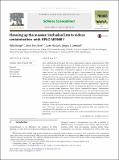Files in this item
Cleaning up the masses : Exclusion lists to reduce contamination with HPLC-MS/MS
Item metadata
| dc.contributor.author | Hodge, K. | |
| dc.contributor.author | Have, S.T. | |
| dc.contributor.author | Hutton, L. | |
| dc.contributor.author | Lamond, A.I. | |
| dc.date.accessioned | 2014-05-14T16:01:05Z | |
| dc.date.available | 2014-05-14T16:01:05Z | |
| dc.date.issued | 2013-08-02 | |
| dc.identifier | 118460154 | |
| dc.identifier | 565c7dd6-1473-4dbe-a9ac-ebb4dccc4888 | |
| dc.identifier | 84893428799 | |
| dc.identifier.citation | Hodge , K , Have , S T , Hutton , L & Lamond , A I 2013 , ' Cleaning up the masses : Exclusion lists to reduce contamination with HPLC-MS/MS ' , Journal of Proteomics , vol. 8 , pp. 92-103 . https://doi.org/10.1016/j.jprot.2013.02.023 | en |
| dc.identifier.issn | 1874-3919 | |
| dc.identifier.uri | https://hdl.handle.net/10023/4793 | |
| dc.description | The work was funded by the Wellcome Trust grant 073980/Z/03/Z (to A.I Lamond). | en |
| dc.description.abstract | Mass spectrometry, in the past five years, has increased in speed, accuracy and use. With the ability of the mass spectrometers to identify increasing numbers of proteins the identification of undesirable peptides (those not from the protein sample) has also increased. Most undesirable contaminants originate in the laboratory and come from either the user (e.g. keratin from hair and skin), or from reagents (e.g. trypsin), that are required to prepare samples for analysis. We found that a significant amount of MS instrument time was spent sequencing peptides from abundant contaminant proteins. While completely eliminating non-specific protein contamination is not feasible, it is possible to reduce the sequencing of these contaminants. For example, exclusion lists can provide a list of masses that can be used to instruct the mass spectrometer to 'ignore' the undesired contaminant peptides in the list. We empirically generated be-spoke exclusion lists for several model organisms (Homo sapiens, Caenorhabditis elegans, Saccharomyces cerevisiae and Xenopus laevis), utilising information from over 500 mass spectrometry runs and cumulative analysis of these data. Here we show that by employing these empirically generated lists, it was possible to reduce the time spent analysing contaminating peptides in a given sample thereby facilitating more efficient data acquisition and analysis. Biological significance. Given the current efficacy of the Mass Spectrometry instrumentation, the utilisation of data from ~500 mass spec runs to generate be-spoke exclusion lists and optimise data acquisition is the significance of this manuscript. This article is part of a Special Issue entitled: EUPA 2012: NEW HORIZONS. | |
| dc.format.extent | 12 | |
| dc.format.extent | 1621269 | |
| dc.language.iso | eng | |
| dc.relation.ispartof | Journal of Proteomics | en |
| dc.subject | Contamination | en |
| dc.subject | Data analysis | en |
| dc.subject | Exclusion list | en |
| dc.subject | MS optimisation | en |
| dc.subject | QH301 Biology | en |
| dc.subject.lcc | QH301 | en |
| dc.title | Cleaning up the masses : Exclusion lists to reduce contamination with HPLC-MS/MS | en |
| dc.type | Journal article | en |
| dc.contributor.institution | University of St Andrews. School of Computer Science | en |
| dc.identifier.doi | 10.1016/j.jprot.2013.02.023 | |
| dc.description.status | Peer reviewed | en |
| dc.identifier.url | http://www.scopus.com/inward/record.url?eid=2-s2.0-84875683193&partnerID=8YFLogxK | en |
This item appears in the following Collection(s)
Items in the St Andrews Research Repository are protected by copyright, with all rights reserved, unless otherwise indicated.

